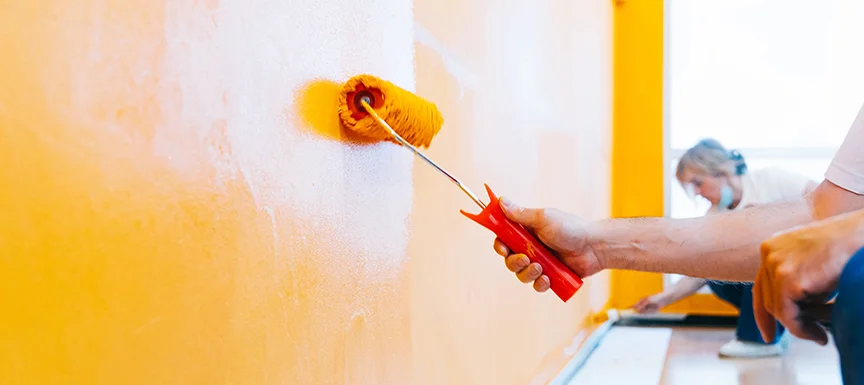Exploring the Different Sorts Of Paint: An Overview for each Project
Checking out the different types of paint is crucial for achieving the preferred result in any kind of task. From water-based choices that supply convenience to oil-based paints understood for their durability, each selection has its benefits. Specialized paints can add distinct textures or coatings, while environmentally friendly choices cater to those seeking sustainability. Understanding these distinctions can considerably influence the success of a painting venture. What elements should one consider when making the appropriate choice?
Recognizing Paint Types: Oil-Based vs. water-based
Paint kinds can considerably influence a task's outcome, and comprehending the differences in between water-based and oil-based paints is necessary for educated decision-making. Water-based paints, typically described as latex paints, are made up of water as the primary solvent. They dry quickly, send out fewer unstable natural compounds (VOCs), and are very easy to tidy up with soap and water. This makes them a preferred option for interior applications and environments where air quality is a concern.
In comparison, oil-based paints use organic solvents, providing a long lasting, glossy coating suitable for surfaces revealed to damage, such as trim and cupboards. They take longer to dry, require mineral spirits for cleaning, and have a stronger odor. paint store corpus christi tx. Choosing in between these 2 kinds depends on the certain needs of the project, considering elements such as desired surface, application atmosphere, and simplicity of upkeep. Each kind has unique advantages and limitations, leading the selection procedure
The Complete Issues: Picking Between Matte, Satin, and Gloss
When picking a paint coating, the option between matte and glossy options significantly affects both aesthetics and functionality. Matte surfaces use a subtle, non-reflective look that can hide surface flaws, while shiny coatings supply toughness and simplicity of cleansing. Understanding the advantages and considerations of each can aid in making a notified decision for any type of paint project.
Matte End Up Benefits
Although several homeowners discuss the benefits of different surfaces, matte paint supplies distinct benefits that make it a preferred option for both interior and outside applications. One of the main advantages of matte coating is its ability to conceal surface blemishes, developing a smoother look on wall surfaces. This top quality is specifically beneficial in older homes or areas with uneven surface areas. Additionally, matte paint takes in light rather than reflecting it, which can enhance the visual of an area by giving a much more low-key and advanced look. Moreover, matte finishes are usually much easier to repair than glossier choices, as they can blend much more flawlessly when used over existing paint. Overall, matte paint is a superb option for those seeking a fine-tuned and stylish coating.
Shiny Finish Considerations
A glossy coating can drastically alter the perception of a room, using a reflective and streamlined quality that improves both shade vibrancy and light within a room. This coating is usually preferred for high-traffic locations and surface areas like kitchen areas and restrooms, where toughness and simplicity of cleansing are important. Its reflective nature can highlight imperfections on walls, making proper surface prep work important. Glossy paints additionally tend to reveal fingerprints and spots quicker, demanding routine maintenance. Additionally, illumination plays a considerable role; in brilliant environments, a glossy coating might produce glare, affecting the overall visual. Consequently, cautious consideration of the particular application and environment is essential when picking a shiny finish for any job.
Specialized Paints: When to Make Use Of Textured or Chalk Paint
Specialty paints, such as distinctive and chalk paint, deal one-of-a-kind aesthetic and useful advantages that can improve numerous surfaces. Distinctive paint is suitable for developing deepness and dimension on walls, hiding blemishes while adding a three-dimensional feel. It is particularly beneficial in high-traffic locations where sturdiness and visual interest are important.

Both types of specialty paints can transform rooms, yet picking the appropriate one relies on the preferred effect and surface needs. Textured paint might fit bigger areas, while chalk paint can rejuvenate smaller sized things, showcasing imagination and personal style in any kind of task.
Outside Paints: Safeguarding Your Surfaces From the Components
Exterior paints are necessary for securing surfaces versus different weather. Recognizing their weather condition resistance functions, proper surface area preparation needs, and efficient application techniques can greatly improve sturdiness and performance. This area will lay out crucial considerations for choose and using exterior paints efficiently.
Weather Resistance Includes
Weather resistance is a crucial function of exterior paints, as it figures out how well surface areas can endure the harsh components of nature. Top quality exterior paints are developed to resist damage from UV rays, dampness, and temperature variations. UV resistance assurances shades stay vivid gradually, preventing fading and staining. Dampness resistance safeguards versus mold and mildew and mildew, which can endanger the integrity of surfaces. In addition, paints with outstanding temperature level resistance can get and expand without splitting, keeping their safety qualities. When selecting outside paints, it is essential to take into consideration these weather resistance functions, as they add to the long read review life and resilience of colored surface areas, ensuring they remain aesthetically pleasing and functional in spite of direct exposure to the aspects.
Surface Area Prep Work Needs
Correct surface area preparation is a fundamental action in achieving the most effective results with outside paints. To ensure suitable attachment and longevity, surface areas have to be extensively cleansed, getting rid of dust, mildew, and grease. This can be completed making use of a stress washer or a scrub brush with an appropriate cleaning solution. Once cleaned, surfaces need to be evaluated for any kind of peeling or flaking paint, which have to be scratched away to produce a smooth foundation. Repairing any kind of splits or openings is additionally crucial, as these can permit wetness infiltration. Additionally, fining sand rough areas advertises much better paint Find Out More bond. Using a primer fit for outdoor usage can improve the paint's efficiency, ensuring a lasting coating that stands up to the elements. Correct preparation is vital to an effective outdoor paint project.
Application Strategies Tips
While applying exterior paints, it is important to utilize efficient techniques that ensure surfaces are well-protected versus the elements. Select the appropriate day for painting; reduced humidity and moderate temperature levels enhance attachment and drying. Prepping the surface extensively-- cleaning, fining sand, and priming-- ensures much better paint attachment and sturdiness. Making use of premium brushes or rollers can give a smoother finish, while spray painting might cover huge areas effectively. Using paint in thin, even coats protects against drips and runs. It is recommended to comply with supplier instructions relating to drying out times in between coats. Verify proper ventilation during application to assist in drying out and decrease direct exposure to fumes. These techniques significantly improve the durability and efficiency of exterior paint.
Eco-Friendly Options: Low-VOC and Zero-VOC Paints
As customers come to be significantly knowledgeable about the ecological influence of their selections, low-VOC and zero-VOC paints have actually arised as popular alternatives. These paints are formulated to contain fewer volatile organic substances (VOCs), which are chemicals that can vaporize right into the air and add to air pollution and illness. Low-VOC paints typically contain a minimal amount of VOCs, while zero-VOC paints have negligible levels, making them safer for both exterior and indoor usage.
The advantages of utilizing zero-voc and low-voc paints expand beyond environmental factors to consider; they additionally boost indoor air quality, minimizing the danger of respiratory issues and sensitive reactions. Many suppliers currently provide a variety of shades and surfaces in environment-friendly choices, making it simpler for customers to discover appropriate items for their jobs. By choosing for these paints, people can add to a healthier setting while still attaining the aesthetic they want in their areas.
Tools and Strategies for a Flawless Application
Attaining a perfect paint application requires look at these guys the right devices and techniques, which can substantially improve the last result. Selecting the proper brush or roller is vital; brushes function well for edges and complex areas, while rollers cover bigger surface areas effectively. Using premium products assures far better paint circulation and reduces touches. For perfect outcomes, surface preparation is essential. This consists of cleansing, sanding, and priming surfaces to advertise adhesion.
Method additionally plays a significant function. The "W" approach with a roller helps to uniformly disperse paint, while long, smooth strokes with a brush prevent visible lines. Operating in sections allows for much better control and mixing. Additionally, using slim coats is more suitable to thick layers, minimizing the threat of drips and uneven structures. Ultimately, maintaining a wet edge throughout application aids achieve seamless modifications in between locations. By incorporating these strategies and tools, one can achieve a refined and expert surface.
Tips for Maintaining and Taking Care Of Your Painted Surfaces
Correct maintenance and care of painted surfaces can significantly prolong their life expectancy and protect their look. Routine cleaning is necessary; utilizing a soft fabric or sponge with moderate soap and water can eliminate dust and dirt without damaging the paint. It is advisable to avoid abrasive cleansers or rubbing pads, as these can damage the surface area. In addition, using a fresh coat of paint every few years can protect and rejuvenate the shade versus wear.
For exterior surface areas, checking for indications of peeling or fading frequently is very important. Quickly dealing with any issues protects against more damages. In areas susceptible to wetness, such as shower rooms, making use of mold-resistant paint and making sure proper ventilation can aid keep the honesty of the paint. Ultimately, making use of protective surfaces can shield against UV rays and discolorations, making sure that painted surface areas remain attractive and dynamic for many years to find, ultimately improving the overall visual of the area.
Often Asked Questions
Can I Mix Different Types of Paint With Each Other?
Blending various kinds of paint is normally not suggested, as it can result in issues like poor attachment, irregular structure, or unforeseen chain reaction. It's best to make use of suitable paints for optimal outcomes and toughness.

Just how Do I Properly Store Extra Paint?
To effectively store leftover paint, secure the container tightly, label it with the date and shade, and maintain it in a cool, dry location far from straight sunshine and severe temperatures for optimal conservation.
What Is the Ideal Means to Deal With Unused Paint?
The very best means to take care of extra paint is to check local policies, as numerous areas have designated contaminated materials centers. Take into consideration giving away functional paint to neighborhood organizations or schools for their projects.
How Can I Inform if Paint Is Still Excellent to Utilize?
To figure out if paint is still great, examine its scent, shade, and consistency. If it shows up separated, has an unpleasant smell, or shows significant adjustments in structure, it's likely no more useful.
Exist Age Restrictions for Acquiring Paint Products?
In numerous areas, there are no certain age restrictions for purchasing paint items. Some shops may call for clients to be at the very least 18 years old, especially for products consisting of solvents or dangerous products.
Paint types can considerably influence a job's outcome, and recognizing the differences in between water-based and oil-based paints is essential for notified decision-making. Water-based paints, frequently referred to as latex paints, are made up of water as the primary solvent. In comparison, oil-based paints make use of organic solvents, giving a resilient, shiny finish suitable for surface areas subjected to put on and tear, such as trim and closets. Specialty paints, such as textured and chalk paint, deal distinct visual and practical benefits that can boost various surface areas. In areas prone to wetness, such as bathrooms, using mold-resistant paint and making sure correct ventilation can assist keep the honesty of the paint.